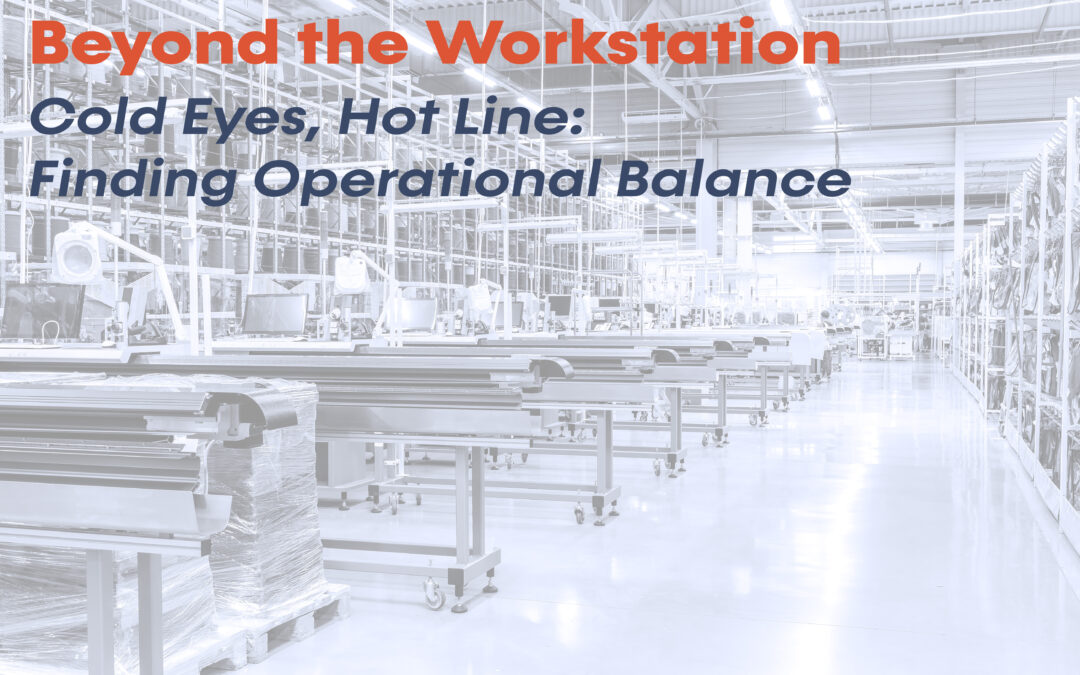Facilities are dynamic environments. A perfectly planned structure and workflow can quickly evolve as operators find locally optimized solutions. While this adaptation can be beneficial, if managers don’t proactively address the resulting changes, these local optimizations can start to interact in globally sub-optimal ways, leading to bottlenecks, clutter, and increased stress for everyone involved. This can create systemic operational and cultural problems within the facility.
Maintaining Balance: A Proactive Approach
Just as a doctor conducts a thorough physical examination to identify underlying health issues, a “cold eyes” review requires a detached and objective assessment of your operational flow to uncover hidden imbalances. This objective perspective allows you to identify and address potential issues before they escalate into major problems. This approach can be applied not only to the overall facility but also to individual workstations.
To truly understand the balance within your facility, you need to consider the interplay of various factors:
-
- Customer Demand vs. Internal Constraints: Can the facility consistently meet customer demands while staying within resource limitations and budget constraints? For example, are frequent production delays impacting customer satisfaction and potentially jeopardizing future orders? A mismatch here can lead to lost revenue and damaged customer relationships.
- Speed vs. Accuracy: Is the emphasis on speed compromising accuracy, leading to increased error rates, rework, and customer dissatisfaction? A focus on speed at the expense of accuracy might get products out the door faster initially, but the resulting returns and complaints can ultimately slow things down and increase costs.
- Cost vs. Quality: Are cost-cutting measures negatively impacting product quality or customer satisfaction? For example, are lower-cost materials leading to increased product defects or shorter product lifespans? While reducing costs is important, it shouldn’t come at the expense of quality, which can damage your brand reputation.
Understanding a Balanced Line
Let’s consider a simple three-step production line where the second step is the rate-limiting factor: 
It’s crucial to understand that efforts to speed up steps one and three won’t increase the overall capacity of the assembly line. The bottleneck at step two limits all other production to its rate. If we look at utilization metrics instead of just processing rates, the problem becomes even clearer:

This scenario is a classic sign of a stressed operation. Given these rates, the operators at steps one and three will have significant downtime, while the operator at step two will be constantly working to keep up. This imbalance can lead to frustration, burnout, and even errors at step two, further impacting overall production.
While analyzing a simple line with hard data is relatively straightforward, gathering this data in a large or complex operation can be challenging. So, how can you gain insights with less reliance on time studies?
Conducting a “Cold Eyes” Assessment
Here are some key strategies for identifying how balanced your operation is:
-
- Observe and Analyze WIP Flow: Where is work in progress (WIP) accumulating? A buildup of work before a particular step is a clear indicator of a bottleneck. Are materials flowing smoothly, or are there areas of excessive inventory buildup next to areas that are surprisingly clear and waiting for work?
- Assess Operator Workload and Behavior: Are operators consistently rushing to meet deadlines, leading to errors and increased stress? Are operators spending significant time idle due to a lack of work or waiting for materials? Are there visible signs of frustration or burnout? A well-balanced operation aims for a consistent workload without excessive pressure or prolonged periods of inactivity.
- Evaluate Machine Utilization: Are critical machines experiencing frequent breakdowns or unexpected downtime? Are there long periods of inactivity for key equipment? Is machine capacity being utilized efficiently, or are there instances of underutilization or overutilization?
- Review Documentation: Analyze production schedules, quality reports, and maintenance logs to identify trends and potential problem areas.
- Benchmark: Compare your operational metrics against industry best practices to identify areas for improvement.
- Map the Process Flow: Create a visual representation of your process to identify potential bottlenecks and inefficiencies.
Engage Operators
Encourage operators to participate in the “cold eyes” assessment of their own workstations. They have valuable insights into the daily challenges and inefficiencies they face.
For example, imagine a “cold eyes” assessment of an assembly line. An observer might notice that one workstation consistently experiences bottlenecks due to a poorly designed tool layout. By applying the “cold eyes” approach, the team can identify this issue and implement improvements, such as reorganizing the workstation to improve tool accessibility and workflow.
Continuous Improvement Through “Cold Eyes”
To facilitate these “cold eyes” assessments, consider the following:
-
- Create a Checklist: Develop a simple checklist to record observations on WIP levels, operator activity, machine utilization, and other relevant factors.
- Analyze the Data: Analyze the collected data to identify recurring patterns and trends.
- Involve Stakeholders: Involve operators, supervisors, and other stakeholders in the assessment process to gather their feedback and insights.
By regularly conducting these “cold eyes” assessments and using the data to inform operational decisions, you can proactively identify and address imbalances, optimize your operational flow, improve morale, increase efficiency, and ultimately boost profitability. This commitment to continuous improvement will help your facility thrive in the long run.
For more information on optimizing operational flow and addressing constraints, you may find the Theory of Constraints Institute’s resources helpful.

